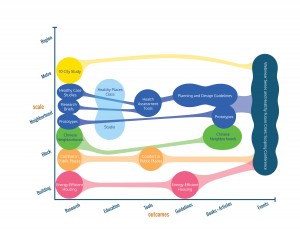About HAPI
There are many links between health and the built environment, from air quality to food access. The Health and Places Initiative (HAPI) project created and synthesized the evidence base linking landscape, urban design, planning, and health.
The Health and Places Initiative (HAPI) investigated how to create healthier cities in the future, with a specific emphasis on China. Bringing together experts from the Harvard Graduate School of Design (HGSD) and the Harvard T.H. Chan School of Public Health (HSPH), it created a forum for understanding the multiple issues that face cities in light of rapid urbanization and an aging population worldwide. As of the 2017-2018 school year, parts of this initiative have been folded into the Healthy Places Design Lab at the Graduate School of Design.
Who We Are
This project has had two phases. The second phase of the project, from 2016 to 2017, collaborated with the Joint Center for Housing Studies and the Harvard Center for Green Buildings and Cities. It is:
- Investigating collaborative approaches to creating healthier places including healthy cities programs,
- Examining how suburbs can support an aging population,
- Exploring opportunities in creating healthier new developments such as new towns, and
- Evaluating place-based health assessment tools.
More detail about these projects is available elsewhere on the site.
A number of educational opportunities are also available:
- A new joint degree between the Masters in Urban Planning and the Masters in Public Health has been approved. The first students will enter in 2017 and information will be available later in 2016.
- GSD 5330: Healthy Places will evolve to engage several key challenges in the realms of: demographics (aging), place (expanding suburbia), process (collaborative interdiciplinary approaches), and key health topics (energy balance).
Prior Work
In the first phase, from 2013-2015, the project investigated the scope and possibilities for creating healthier places in the future, with a specific emphasis on China. The project brought together experts from the Harvard Graduate School of Design (HGSD) and the Harvard T.H. Chan School of Public Health (HSPH) to create a forum for understanding the multiple issues that face cities in light of rapid urbanization and an aging population worldwide. Through the work of dedicated faculty and researchers, the project developed templates for alternative models of urban development, stressing their impact on health and aging.
In the first phase the project had three main components: education, research, and next steps. Area 1, focused on education, includes courses taken by students in both the design and public health schools, Harvard Extension School courses, and a webinar series. Area 2, on research, has components at the building, neighborhood and city scale. Finally, it created a forum for further work on the connections between built environments and public health. Click on the image below to view larger.




